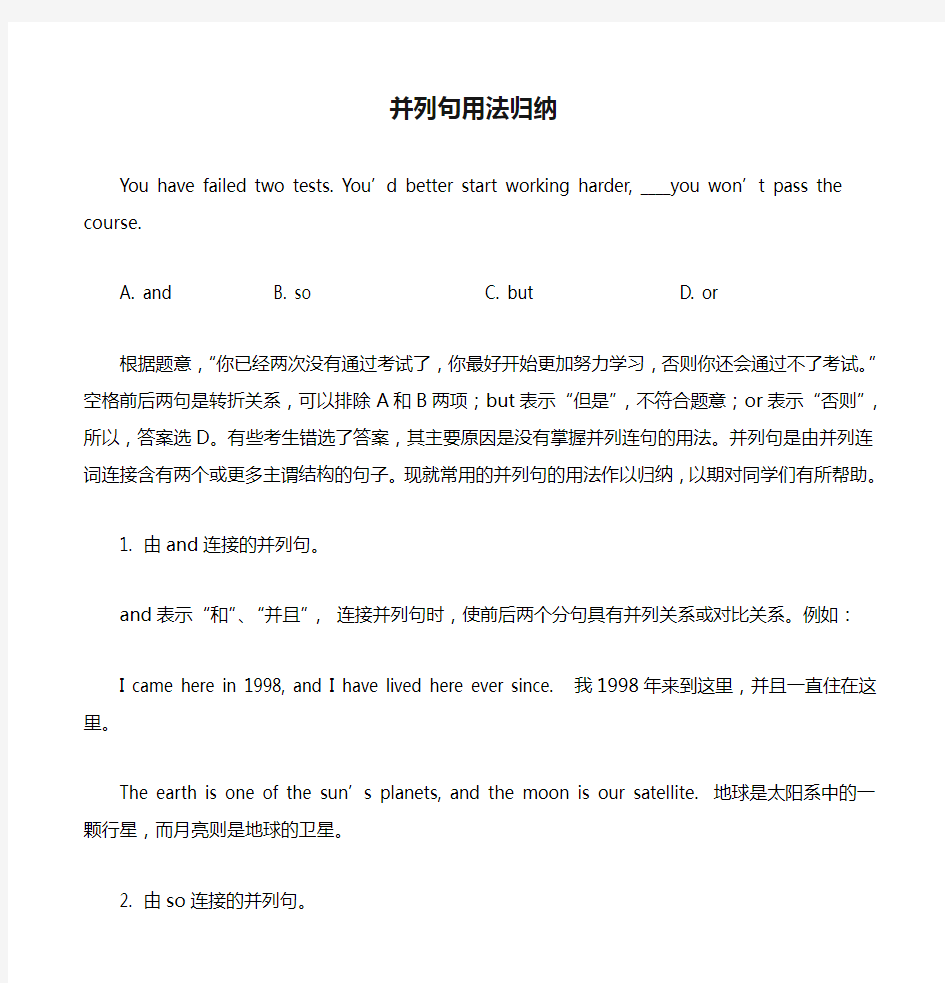并列句用法归纳


并列句用法归纳
You have failed two tests. You’d better start working harder, ____you won’t pass the course.
A. and
B. so
C. but
D. or
根据题意,“你已经两次没有通过考试了,你最好开始更加努力学习,否则你还会通过不了考试。”空格前后两句是转折关系,可以排除A和B两项;but表示“但是”,不符合题意;or表示“否则”,所以,答案选D。有些考生错选了答案,其主要原因是没有掌握并列连句的用法。并列句是由并列连词连接含有两个或更多主谓结构的句子。现就常用的并列句的用法作以归纳,以期对同学们有所帮助。
1. 由and连接的并列句。
and表示“和”、“并且”,连接并列句时,使前后两个分句具有并列关系或对比关系。例如:
I came here in 1998, and I have lived here ever since. 我1998年来到这里,并且一直住在这里。
The earth is one of the sun’s planets, and the moon is our satellite. 地球是太阳系中的一颗行星,而月亮则是地球的卫星。
2. 由so连接的并列句。
so表示“因此”、“所以”,连接并列句时,使前后两个分句具有因果关系。例如:
It was late, so we went home. 天晚了,所以我们就回家了。
I’m busy, so I cannot go with you. 因为我很忙。所以我不能与你一起去。
3. 由but连接的并列句。
but表示“可是”、“然而”、“但是”,连接并列句时,使前后两个分句具有转折关系。例如:All this he did, but it had no effect. 这些他都做了,但是却没有效果。
I’m sorry, but I disagree with you all. 对不起,我不同意你们大家的意见。
4. 由or连接的并列句。
or表示“或者”、“或是”、“要不然”,连接并列句时,使前后两个分句具有选择关系或因果并存的关系。例如:
Now you can have a rest or you can go to the cinema.现在你可以休息,或者去看电影。
Hurry up, or you’ll be late foe school. 赶快,要不然你上学就要迟到了。
5. 由for连接的并列句。
for表示“因为”、“由于”,连接并列句时,只表示一种推测或解释,后面的分句通常表示间接的推测原因,前句表示结果,后句表示原因。例如:
The electric current must have been turned off, for the light went out. 想必是停电了,因为灯灭了。
He must have passed this way, for here are footprints. 他想必是从这条路过去的,因为这里有脚印。
6. 由when连接的并列句。
when表示“这时”、“突然那时”,连接并列句时,其前的分句谓语用had done,was (were)doing,was (were)about to do或was (were)on the point of doing;其后的分句表示一个突然发生的情况,谓语用一般过去时。
I had just finished dinner when someone knocked at the door.我刚吃完饭,突然那时有人敲门。
I was talking with a friend when he burst into the room.我正在和一位朋友谈话,这时他闯进了房间。
They were about to go to work when it began to rain heavily.他们正准备去上班,突然这时天下起了大雨。
I was on the point of going out when the telephone rang.我正要出去,这时电话响了。
7. 由while连接的并列句。
while表示“然而”、“却”、“可是”,连接并列句时,使前后两个分句具有对比关系或转折关系。例如:
He wants to be a writer, while I want to be a scientist. 他想当作家,而我则想当科学家。
You like sports, while I’d rather read. 你喜欢运动,而我却宁愿读书。
8. 由yet连接的并列句。
yet表示“然而”、“可是”,连接并列句时,使前后两个分句具有转折关系,强调在尽可能做出让步后仍未出现预期的结果,也可在yet前加and,放在后一个句子的句首。例如:
He is thin, yet he is health. 他虽然瘦,却很健康。
It was a fine day, and yet I didn’t want to go out. 天气很好,可是我不想出去。
9. 由not only…but also…连接的并列句。
not only…but also…表示“不但……而且……”,连接并列句时,使连接的两个分句具有递进关系,not only用在句首时,其后的分句用部分倒装语序。例如:
Not only was the city polluted but also the streets were crowded. 不仅城市受到污染,而且街道也拥挤不堪。Not only was everything he had taken away from him, but also his German citizenship.不仅他所有的一切都被没收或撤消了,而且连他的德国公民权也被剥夺了。
10. 由not…but…连接的并列句。
not…but…表示“不是……而是……”,连接并列句时,使连接的并列句具有对比关系,一个表示否定,另一个表示肯定。例如:
I didn’t eat the apple but she did. 我没有吃苹果,但是她吃了。
He won’t go but they will (go). 他不愿去,而他们愿意去。
11. 由either…or…连接的并列句。
either…or…表示“或者……或者……”、“不是……就是……”,连接并列句,用正常语序,在or前用逗号。
Either you can do it by yourself, or you can ask someone else to do it. 你或者自己做,或者让别人去做。Either my uncle can do it, or my aunt can do it. 我叔叔可以做那件事,或者我婶婶也可以做。
